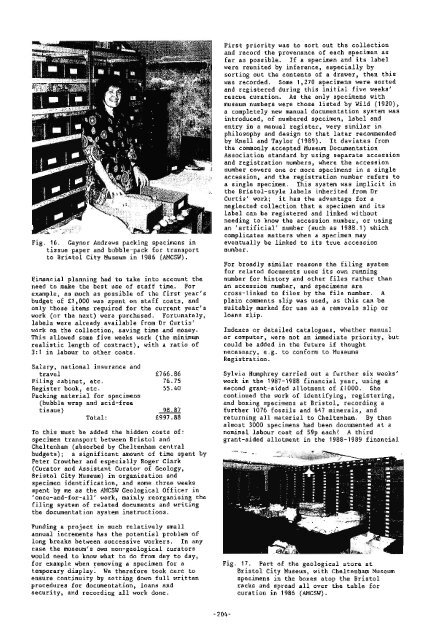Number 5 - Geological Curators Group
Number 5 - Geological Curators Group
Number 5 - Geological Curators Group
Create successful ePaper yourself
Turn your PDF publications into a flip-book with our unique Google optimized e-Paper software.
Fig. 16. Caynor Andrews packing specimens intissue paper and bubble-pack for transportto Bristol City Museum in 1986 (AMCSW).Financial planning had to take into account theneed to make the best use of staff time. Forexample, as much as possible of the first year'sbudget of £1,000 was spent on staff casts, andonly those items required for the current year'swork (or the next) were purchased. Fortunately,labels were already available from Dr Curtis'work on the collection, saving time and money.This allowed some five weeks work (the minimumrealistic length of contract), with a ratio of3:l in labour to other costs.Salary, national insurance andtravelFiling cabinet, etc.£766.8676.75Register book, etc.Packing material for specimens55.40(bubble wrap and acid-freetissue) 98.87Total: £997.88To this must be added the hidden costs of:specimen transport between Bristol andCheltenham (absorbed bv Cheltenham centralbudgets); a significant amount of time spent byPeter Crowther and especially Roger Clark(Curator and Assistant Curator of Geology,Bristol City Museum) in organisation andspecimen identification, and some three weeksspent by me as the AMCSW <strong>Geological</strong> Officer in'once-and-for-all' work, mainly reorganising thefiling system of related documents and writingthe documentation system instructions.Funding a project in such relatively smallannual increments has the potential problem oflong breaks between successive workers. In anycase the museum's own non-geological curatorswould need to know what to do from dav to dav. ,.for example when removing a specimen for atemporary display: We therefore took care toensure continuity by setting dawn full writtenprocedures for documentation, loans andsecurity, and recording all work done.First priority was to sort out the collectionand record the provenance of each specimen asfar as possible. If a specimen and its labelwere reunited by inference, especially bysorting out the contents of a drawer, then thiswas recorded. Same 1,270 specimens were sortedand registered during this initial five weeks'rescue curation. As the only specimens withmuseum numbers were those listed by Wild (1920),a completely new manual documentation system wasintroduced, of numbered specimen, label andentry in a manual register, very similar inphilosophy and design to that later recommendedby Knell and Taylor (1989). It deviates fromthe commonly accepted Museum DocumentationAssociation standard by using separate accessionand registration numbers, where the accessionnumber covers one or more specimens in a singleaccession, and the registration number refers toa single specimen. This system was implicit inthe Bristol-style labels inherited from DrCurtis' work; it has the advantage far aneglected collection that a specimen and itslabel can be registered and linked withoutneeding to know the accession number, or usingan 'artificial' numher (such as 1988.1) whichcomplicates matters when a specimen mayeventually he linked to its true accessionnumber.For broadly similar reasons the filing systemfor related documents uses its own runningnumher for history and other files rather thanan accession number, and specimens arecross-linked to files by the file number. Aplain comments slip was used, as this can besuitably marked for use as a removals slip orloans slip.Indexes or detailed catalogues, whether manualor computer, were not an immediate priority, butcould he added in the future if thoughtnecessary, e.g. to conform to MuseumsRegistration.Sylvia Humphrey carried out a further six weeks'work in the 1987-1988 financial year, using asecond grant-aided allotment of £1000. Shecontinued the work of identifying, registering,and boxing specimens at Bristol, recording afurther 1076 fossils and 647 minerals, andreturning all material to Cheltenham. By thenalmost 3000 specimens had been documented at anominal labour cost of 59p each! A thirdgrant-aided allotment in the 1988-1989 financialFig. 17. Part of the geological store atBristol City Museum, with Cheltenham Museumspecimens in the boxes atop the Bristolracks and spread all over the table forcuration in 1986 (AMCSW).
















